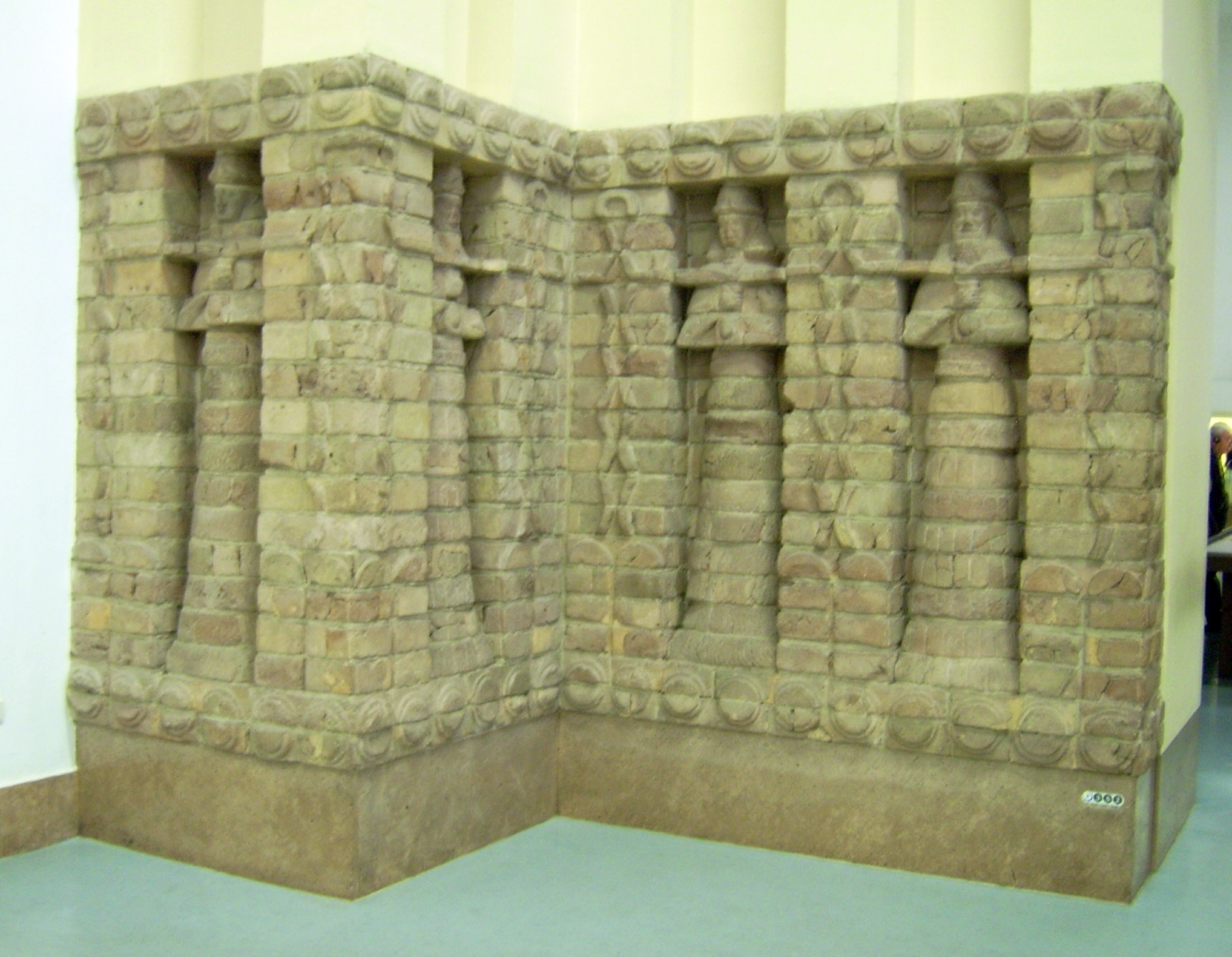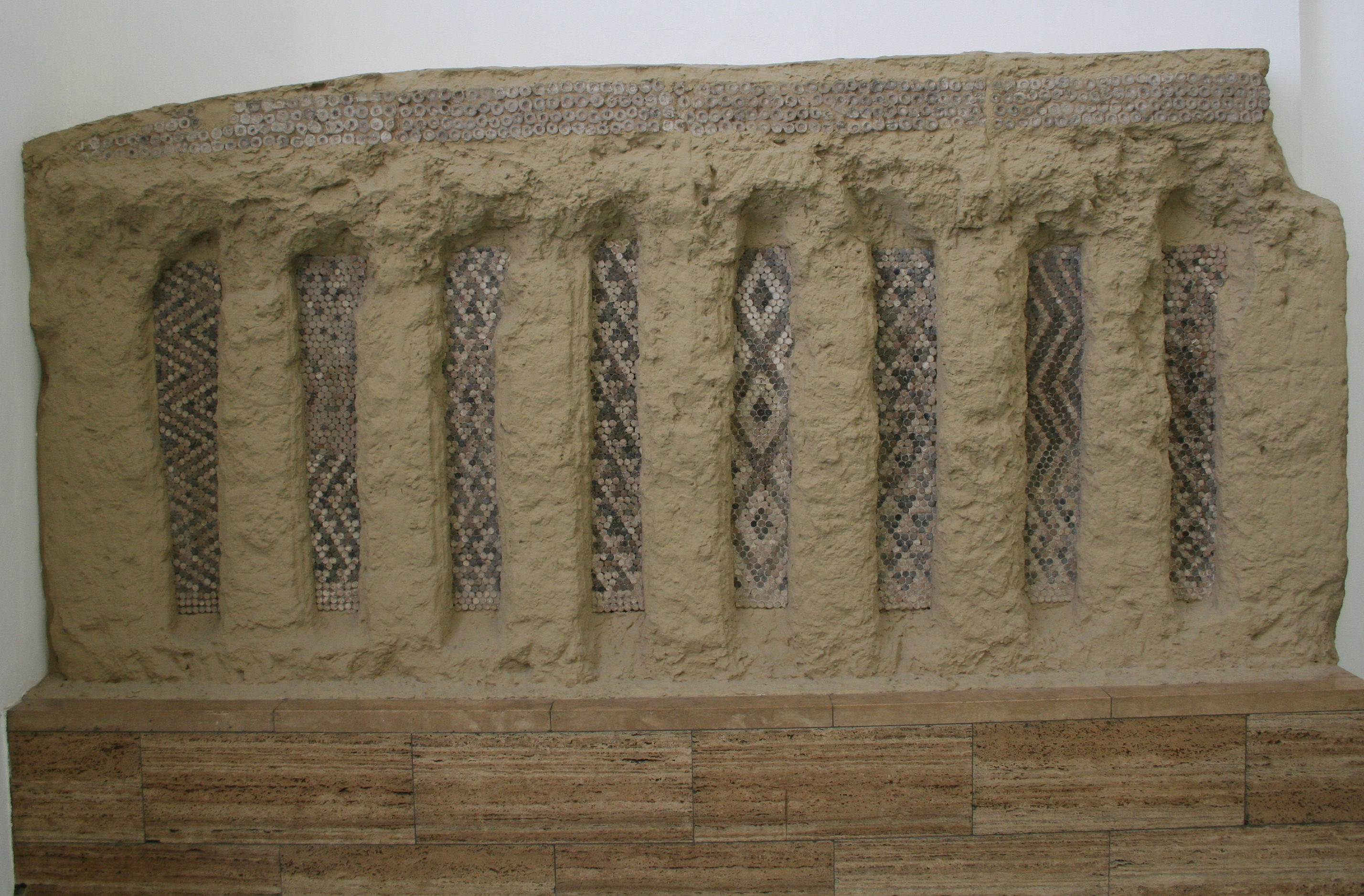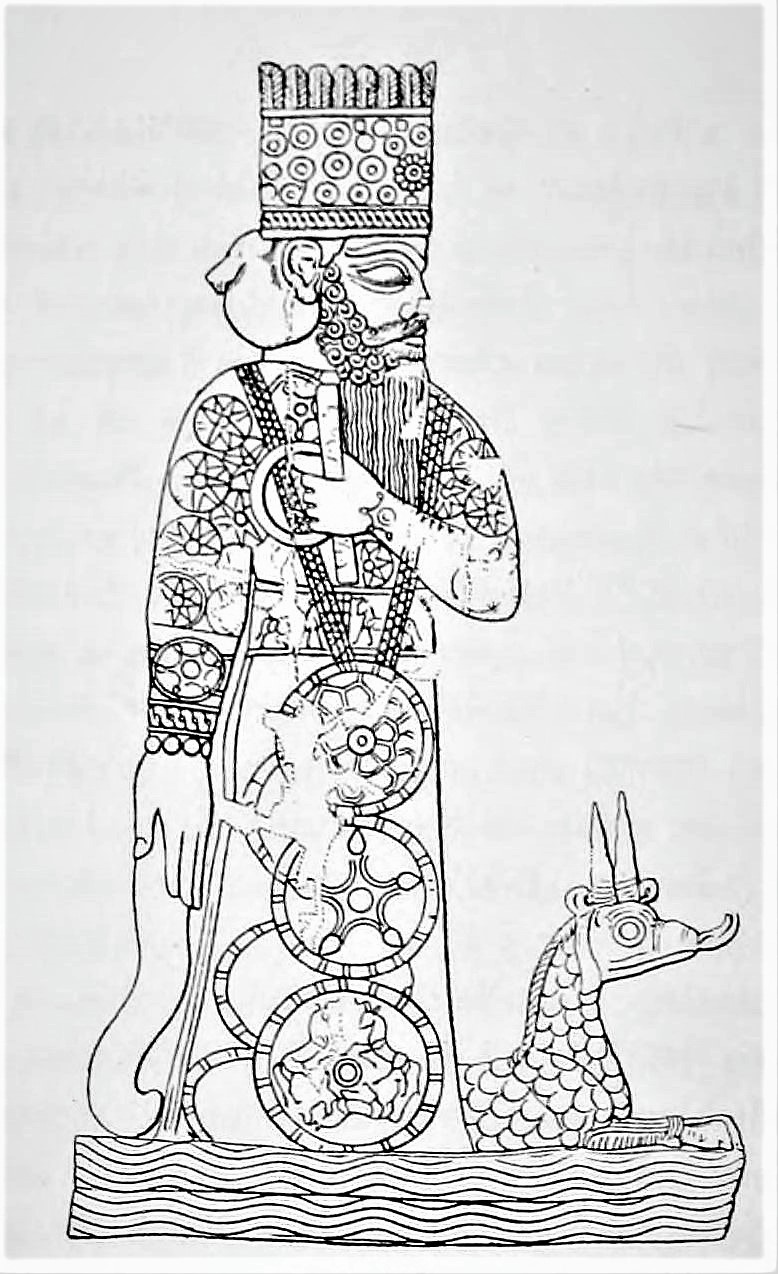|
An (deity)
, image=Detail, upper part, Kudurru of Ritti-Marduk, from Sippar, Iraq, 1125-1104 BCE. British Museum.jpg , caption=Symbols of various deities, including Anu (bottom right corner) on a kudurru of Ritti-Marduk, from Sippar, Iraq, 1125–1104 BCE , deity_of= Sky Father, King of the Gods , abode= heaven , symbol= horned crown on a pedestal , number= 60 , parents= , children= , consort= , Greek_equivalent= Zeus (disputed), Uranus , equivalent1_type= Elamite , equivalent1= Jabru , equivalent2_type= Hurrian , equivalent2= Hamurnu , equivalent3_type= Achaemenid , equivalent3= Ahura Mazda (disputed) Anu ( akk, , from 𒀭 ''an'' “Sky”, “Heaven”) or Anum, originally An ( sux, ), was the divine personification of the sky, king of the gods, and ancestor of many of the deities in ancient Mesopotamian religion. He was regarded as a source of both divine and human kingship, and opens the enumerations of deities in many Mesopotamian texts. At the same time, his role was large ... [...More Info...] [...Related Items...] OR: [Wikipedia] [Google] [Baidu] |
Kudurru
A kudurru was a type of stone document used as a boundary stone and as a record of land grants to vassals by the Kassites and later dynasties in ancient Babylonia between the 16th and 7th centuries BC. The original kudurru would typically be stored in a temple while the person granted the land would be given a clay copy to use to confirm legal ownership. Kudurrus are often linked to what are usually called "ancient kudurrus", land grant stones from the third millennium (typically Sargonic and Ur III) which serve a similar purpose though the word kudurru did not emerge until the 2nd millennium (Middle Babylonian in fact). Background The objects are traditionally called kudurru which is Akkadian for "frontier" or "boundary". because early epigraphers frequently found that word in the text and assumed they were placed in agricultural setting, not the temples they actually were. While there is consensus on the main group of kudurru there are other "debatable kudurru for which opinion ... [...More Info...] [...Related Items...] OR: [Wikipedia] [Google] [Baidu] |
Ki (goddess)
''Ki'' was the earth goddess in Sumerian religion, chief consort of the sky god An. In some legends Ki and An were brother and sister, being the offspring of Anshar ("Sky Pivot") and Kishar ("Earth Pivot"), earlier personifications of heaven and earth. By her consort Anu (also known as Anunna), Ki gave birth to Anunnaki, the most prominent of these deities being Enlil, god of the air. According to legends, heaven and earth were once inseparable until Enlil was born; Enlil cleaved heaven and earth in two. An carried away heaven. Ki, in company with Enlil, took the earth. Ki marries her son, Enlil, and from this union all the plant and animal life on earth is produced. Some authorities question whether Ki was regarded as a deity since there is no evidence of a cult and the name appears only in a limited number of Sumerian creation texts. Samuel Noah Kramer identifies Ki with the Sumerian mother goddess Ninhursag and claims that they were originally the same figure. She later dev ... [...More Info...] [...Related Items...] OR: [Wikipedia] [Google] [Baidu] |
Eanna
E-anna ( sux, , ''house of heavens''), also referred to as the Temple of Inanna, was an ancient Sumerian temple in Uruk. Considered "the residence of Inanna" and Anu, it is mentioned several times in the ''Epic of Gilgamesh The ''Epic of Gilgamesh'' () is an epic poetry, epic poem from ancient Mesopotamia, and is regarded as the earliest surviving notable literature and the second oldest religious text, after the Pyramid Texts. The literary history of Gilgamesh ...'', and elsewhere. The evolution of the gods to whom the temple was dedicated is the subject of scholarly study. The Epic of Gilgamesh From Tablet One: He carved on a stone stela all of his toils, and built the wall of Uruk-Haven, the wall of the sacred Eanna Temple, the holy sanctuary. See also Uruk - Eanna district References External links Ancient Near East temples Mesopotamian religion Uruk Inanna {{Religion-struct-stub ... [...More Info...] [...Related Items...] OR: [Wikipedia] [Google] [Baidu] |
Ancient Mesopotamian Religion
Mesopotamian religion refers to the religious beliefs and practices of the civilizations of ancient Mesopotamia, particularly Sumer, Akkad, Assyria and Babylonia between circa 6000 BC and 400 AD, after which they largely gave way to Syriac Christianity practiced by today's Assyrians. The religious development of Mesopotamia and Mesopotamian culture in general, especially in the south, was not particularly influenced by the movements of the various peoples into and throughout the area. Rather, Mesopotamian religion was a consistent and coherent tradition which adapted to the internal needs of its adherents over millennia of development. The earliest undercurrents of Mesopotamian religious thought are believed to have developed in Mesopotamia in the sixth millennium BC, coinciding with the region beginning to be permanently settled. The earliest evidence of Mesopotamian religion date to the mid-fourth millennium BC, coinciding with the invention of writing, and involved th ... [...More Info...] [...Related Items...] OR: [Wikipedia] [Google] [Baidu] |
List Of Mesopotamian Deities
Deities in ancient Mesopotamia were almost exclusively anthropomorphic. They were thought to possess extraordinary powers and were often envisioned as being of tremendous physical size. The deities typically wore ''melam'', an ambiguous substance which "covered them in terrifying splendor" and which could also be worn by heroes, kings, giants, and even demons. The effect that seeing a deity's ''melam'' has on a human is described as ''ni'', a word for the " physical creeping of the flesh". Both the Sumerian and Akkadian languages contain many words to express the sensation of ''ni'', including the word ''puluhtu'', meaning "fear". Deities were almost always depicted wearing horned caps, consisting of up to seven superimposed pairs of ox-horns. They were also sometimes depicted wearing clothes with elaborate decorative gold and silver ornaments sewn into them. The ancient Mesopotamians believed that their deities lived in Heaven, but that a god's statue was a physical embodime ... [...More Info...] [...Related Items...] OR: [Wikipedia] [Google] [Baidu] |
𒀭
''Dingir'' (, usually transliterated DIĜIR, ) is a Sumerian word for "god" or "goddess". Its cuneiform sign is most commonly employed as the determinative for religious names and related concepts, in which case it is not pronounced and is conventionally transliterated as a superscript "d" as in e.g. dInanna. The cuneiform sign by itself was originally an ideogram for the Sumerian word ''an'' ("sky" or "heaven");Hayes, 2000 its use was then extended to a logogram for the word ''diĝir'' ("god" or "goddess")Edzard, 2003 and the supreme deity of the Sumerian pantheon ''An'', and a phonogram for the syllable . Akkadian took over all these uses and added to them a logographic reading for the native '' ilum'' and from that a syllabic reading of . In Hittite orthography, the syllabic value of the sign was again only ''an''. The concept of "divinity" in Sumerian is closely associated with the heavens, as is evident from the fact that the cuneiform sign doubles as the ideogram f ... [...More Info...] [...Related Items...] OR: [Wikipedia] [Google] [Baidu] |
Ahura Mazda
Ahura Mazda (; ae, , translit=Ahura Mazdā; ), also known as Oromasdes, Ohrmazd, Ahuramazda, Hoormazd, Hormazd, Hormaz and Hurmuz, is the creator deity in Zoroastrianism. He is the first and most frequently invoked spirit in the ''Yasna''. The literal meaning of the word ''Ahura'' is "lord", and that of ''Mazda'' is "wisdom". The first notable invocation of Ahura Mazda occurred during the Achaemenid period () with the Behistun Inscription of Darius the Great. Until the reign of Artaxerxes II (), Ahura Mazda was worshipped and invoked alone in all extant royal inscriptions. With Artaxerxes II, Ahura Mazda was gathered in a triad with Mithra and Anahita. In the Achaemenid period, there are no known representations of Ahura Mazda at the royal court other than the custom for every emperor to have an empty chariot drawn by white horses to invite Ahura Mazda to accompany the Military history of Iran#Achaemenid Era, Persian army on battles. Images of Ahura Mazda, however, were pre ... [...More Info...] [...Related Items...] OR: [Wikipedia] [Google] [Baidu] |
Earth And Heaven (Hurrian Religion)
Earth and Heaven (Eše Hawurni) were worshiped by various Hurrian communities in the Ancient Near East. While considered to be a part of the Hurrian pantheon, they were not envisioned as personified deities. They were also incorporated into the Mesopotamian pantheon, possibly during the period of Mitanni influence over part of Mesopotamia, and under the names Hahharnum and Hayyashum appear in a variety of texts, including the myth '' Theogony of Dunnu''. Earth and Heaven in Hurrian religion The Hurrian term referring to the concept of a divine Earth and Heaven was ''eše hawurni''. The deified Earth appears alongside the deified Heaven as a pair. According to Piotr Taracha, the Earth-Heaven pair should be considered "pan-Hurrian," similar to Teshub, Šauška, Kumarbi, Šimige and Kušuḫ, and as such can be found in religious texts from all areas inhabited by Hurrians, from Kizzuwatna in modern Turkey to the Zagros Mountains. However, they were not regarded as personified deities. ... [...More Info...] [...Related Items...] OR: [Wikipedia] [Google] [Baidu] |
Jabru
Jabru was a god who according to Mesopotamian god lists was worshiped in Elam. However, he is not attested in any Elamite sources. Mesopotamian attestations While Jabru is described as an Elamite god, he is known exclusively from Mesopotamian texts, and attestations of him are infrequent. An Elamite town named Jabru did exist, but according to the Assyrian Takultu text its tutelary deity was a goddess named Jabrītu. It was located close to the border of Elam and Babylonia, and appears in an inscription of Amar-Sin mentioning it was destroyed alongside Huhnur, presumed to be the cult center of Ruhurater. According to a Šurpu commentary, Jabru was the Elamite equivalent of the Mesopotamian sky god Anu. However, according to the god list ''An = Anum'', a god bearing the name Yabnu (''dia-ab-na'') was the Enlil of Elam. Wilfred G. Lambert concludes that both of them are spellings of the same name. In an Assyrian text known as ''The underworld Vision of an Assyrian Prince'' (VAT ... [...More Info...] [...Related Items...] OR: [Wikipedia] [Google] [Baidu] |
Uranus (mythology)
In Greek mythology, Uranus ( ), sometimes written Ouranos ( grc, Οὐρανός, , sky, ), is the personification of the sky and one of the Greek primordial deities. According to Hesiod, Uranus was the son and husband of Gaia (Earth), with whom he fathered the first generation of Titans. However, no cult addressed directly to Uranus survived into Classical times, and Uranus does not appear among the usual themes of Greek painted pottery. Elemental Earth, Sky, and Styx might be joined, however, in solemn invocation in Homeric epic. Uranus is associated with the Roman god Caelus and the Jewish god Yahweh. Etymology Most linguists trace the etymology of the name to a Proto-Greek form ''*Worsanós'' (), enlarged from *''ṷorsó-'' (also found in Greek ''()'' 'to urinate', Sanskrit ''varṣá'' 'rain', Hittite ''ṷarša-'' 'fog, mist').Robert S. P. Beekes, ''Etymological Dictionary of Greek'', vol. 2 (Leiden: Brill, 2009), 1128–1129. The basic Indo-European root is ''* ... [...More Info...] [...Related Items...] OR: [Wikipedia] [Google] [Baidu] |




_-_EnKi_(Sumerian).jpg)



